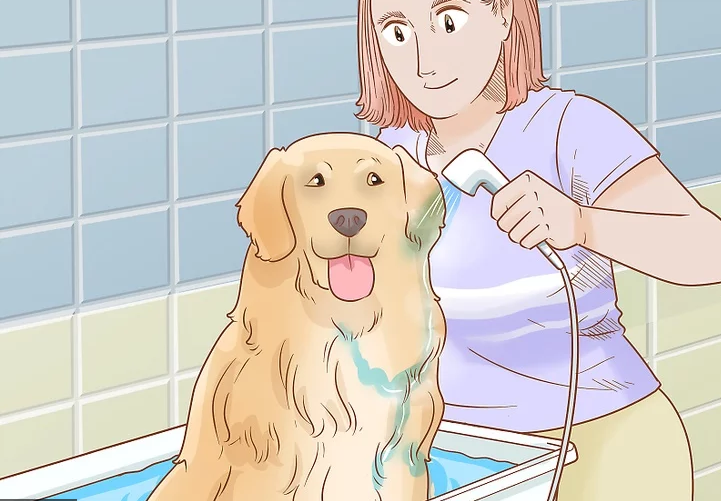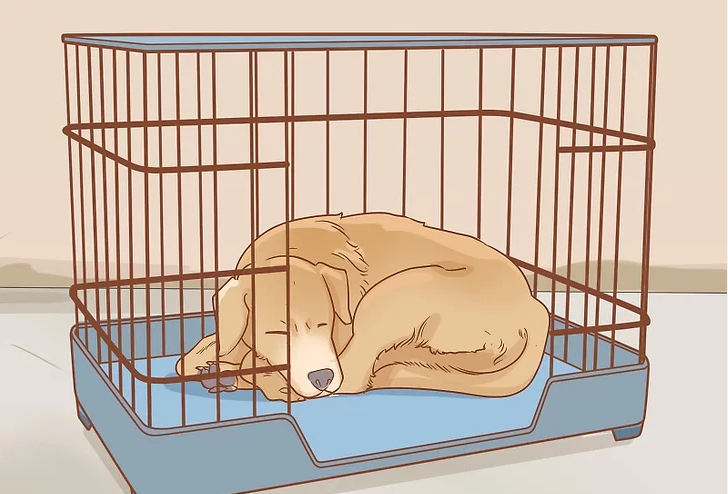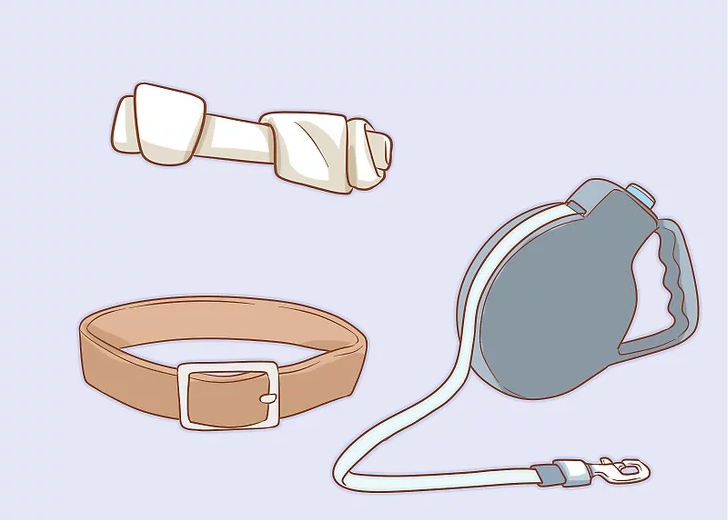Are you considering bringing a dog into your home? Dogs are pious and loving musketeers and generally give us back way further than we give them; still, they do bear a lot of care to stay healthy and happy. However, there are numerous effects to consider to insure a long and healthy fellowship, If you're planning on bringing a canine into your home.
MORE: New & Most Important Pet Guide
1.1. Purchase a brand of food with high-quality ingredients: You could also make your own dog food. Do not feed your dog too important sugar, fried food, or other treats for people. These will harm your dog's health over time. noway feed dog chocolate.
- Generally, large-strain dogs should be fed a large-strain puppy dog formula until they're around one time of age. They also should be transitioned to a grown-up diet until changing to an elderly diet at around six times of age. Small and medium types should be fed puppy dog formula until around one time of age when they should be changed to a grown-up diet.
- If a youthful canine becomes fat it's fine to switch them to adult food( which is lower spicy) before they're 12 months old.
1.2. Feed your dog on a regular schedule: Different dogs have different requirements when it comes to food. However, he or she may need several refections a day, If your dog is under one time old. This can be reduced to twice a day for the utmost dogs when they're around six months old. It's normal for some dogs as they get aged and generally less active, to only want to eat formerly a day. (1)
- Try to feed your dog at the same time every day. This helps your dogs to know when mealtime is and helps you to know how important your dog is eating. This can be important if you're trying to housebreak a dog if a drop in appetite occurs, and also in precluding rotundity.
1.3. Monitor your dog's appetite and eating habits: The applicable quantum of food should be measured to allow you to gauge how important your dog is eating. Allow your dog to eat for about 10 – 15 twinkles and also the coliseum should be picked up until the coming feeding time. If they do not eat all of the food at this time they will be peckish and more likely to finish it at their coming feeding.
- A good way to tell if your dog is getting enough or too important food is to cover their weight and appearance. While for some further active types with certain body types, seeing their caricatures can be normal, for utmost tykes that's a sign that they aren't getting enough to eat. Also, if you can not feel their caricatures also they may be getting too important to eat. Always check with your veterinarian if there's a question about what your dog should weigh or look like.
- Free feeding, which is having food always available, can be an easy way to feed; still, it's discouraged. The good eater is liable to gain weight, and the fussy eater does not get the excitement of mealtimes. Try to stick to feeding your dog on a regular schedule.
- Puppies that are getting fat may need adaptations to their feeding quantities and exercise routines. It's stylish to consult with your veterinarian before making any changes.
- Dogs should be switched to an elderly diet at around eight times of age. This helps to help inordinate calorie input and weight gain which can do in an aged, less active dog. It's essential to always have fresh water available at all times. (2)
1.4. Provide water at all times: Keeping your dog's water bowl full of fresh water is essential. tykes need to be suitable to drink when they are thirsty, and there is no detriment in them drinking as important water as they want. You can put many ice cells in the water to keep it nice and cold when it's hot outdoors.
1.5. Make sure your dog gets plenty of exercises: Dogs need to be suitable to run around and play to stay healthy and happy. (3) In general, take your canine for at least one, 30 twinkles, walk a day, although this may not be near enough exertion for a high-energy dog. (4)
- Simply taking your dog outdoors to relieve itself is not enough exercise. Make sure the dog gets tired out a bit every single day.
- The quantum of exercise your dog requires will depend on their age, strain, health, and overall position of energy. youngish, veritably energetic types will bear much further exercise than aged, less active bones Keep in mind that some types aren't suited to as important exercise as others.
- Still, find a place where it's legal to remove the leash and let him run around and stretch If you can.
- To avoid damaging developing bones and joints in puppies, it's generally recommended to not take them running or do other repetitious high-impact types of exercises, similar to jumping from high places. As always ask your veterinarian for exercise recommendations.
- Interacting with your dog by playing a variety of games will keep your dog stimulated both physically and mentally while also helping to make a strong bond between the two of you. (5)
- Also depending on your canine's exertion position and your schedule, dog daycare can be a great way to give your canine the exercise they need while allowing them to interact with other tykes and people.
- Inadequate exercise can lead to tedium, which can beget numerous guest issues including destructive bones. It can also lead to rotundity, which can beget numerous affiliated health issues and should be avoided at all costs.
- As well as exercise, internal stimulation is vital for a healthy dog. Consider playing games daily, training, and using puzzle feeders, as ways of precluding tedium.
2.1. Groom your dog: Different dog types bear different fixing strategies. As a whole, dogs should be brushed once a week or so to help them exfoliate hair. Long-haired types may need further frequent brushing to avoid developing befuddlements and also may bear regular trims. Some types get hot in the summer and feel more when they are shaved as it starts getting warm outside. Determine what grooming habits are stylish for your dog's fur and nails.
- Check for fleas and ticks while you prepare, and remove them with a flea and tick comb. A quality flea forestallment drug from your veterinarian may be demanded.
2.2. Bathe your dog every couple of weeks: Dogs do not need baths nearly as frequently as humans, but when they start to smell or get into the slush and other messes, it's necessary to give them cataracts. Try to use lukewarm water and natural, gentle shampoo that's made specifically for dogs and that won't irritate their skin.
- Dogs like to run around after a bath, so you might want to time the bath so that the dog can run around outdoors subsequently.
- Bathing and fixing is also a good way to make sure you notice if your dog has a cut or bump that needs medical attention. (6)
2.3. Make sure your dog has routine veterinary care: Regular veterinary check-ups can help or descry problems beforehand. Routine warhorse visits include a physical test, fecal check, and a heartworm test. Your warhorse may also recommend routine blood work to check for underpinning issues that have not surfaced yet and are stylishly treated as beforehand as possible.
- Common regular specifics that your warhorse may recommend include, heartworm precautionary, regular dewormings, and flea and tick forestallment depending on the season and what area of the country you live in.
- Make sure that your canine has had all of its necessary immunizations. This will help to keep them happy and healthy. The standard immunizations for tykes include Rabies, which is administered at 12 weeks of age or age and also every 1 to 3 times depending on your original laws and your warhorse's recommendations. illness, Parvovirus, and Hepatitis are generally administered together. Puppies should admit a set of four injections every three weeks starting at six weeks of age and also annually, as grown-ups, again grounded on your Veterinarian's recommendations. (7)
2.4. Consider getting your dog spayed or neutered: Spaying and neutering are procedures that help unwanted gravidity and can help to exclude numerous health and behavioral issues. Neutering can help testicular cancers, prostate problems, urinary marking, and some aggressive actions in males. Desexed ladies have a greatly reduced prevalence of mammary excrescences and no possibility of uterine infections or uterine cancer.
- Immaculately, a puppy dog should have this done at around six months of age. bandy this procedure with your veterinarian during your regular puppy dog visits or at the first visit after espousing an adult dog.
2.5. Monitor your dog's general health: Knowing your dog's normal eating habits, exertion situations, and weight will help you to fete when effects change and are easy ways to track their health. Monitoring regular restroom habits will help you to notice any changes that can indicate health issues. Regularly checking your canine's mouth, teeth, eyes, and cognizance will help to identify problems as soon as possible. You should check for lumps and cuts regularly. You should observe for any changes in the way your dog walks or moves.
- Consult your veterinarian when you notice any changes in your dog's normal condition.
MORE: Your free Q5 TacLite (Confirm your delivery address)
3.1. Housetrain your dog: When bringing a new puppy dog or adult dog into your house, one of the first effects to negotiate is tutoring them to relieve themselves outdoors, rather than indoors. Dogs of any age can be trained with proper guidance. (8)
- Until trained, there are many rules to follow that will help with the process. Limit the areas your dog has access to so that they can be watched nearly for signs that they're about to go and can be incontinently taken out. (9) Establish a schedule for taking them out that includes, first thing in the morning, after mealtimes, anytime you come home, and just before bedtime.
- Puppies will need to go out more constantly when young and as a rule, can hold their urine for an hour for every month old that they are.
- Keeping your dog on a leash, indeed when indoors, will allow you to cover them more nearly until they're trained. Also, when taking them outdoors, keep them on a leash so you can educate them to go to a specific position and to be sure that you know when they've gone.
- You can use a word similar to" go" to educate them to go to a specific location. However, tell them" no", and take them outdoors, If you catch them starting to go outside. Always praise them when they go where they should.
- Still, be sure to clean the area completely to help them from wanting to go to the same place again, If they have an accident in the house.
- Noway bang or scold a dog for going outside. The dog will only learn to sweat you.
3.2. Crate trains your dog: This will give your dog a place where they feel safe and content when you aren't home and this is another popular option to help accidents. (10)
- With this system, try to make the jalopy a delightful place by giving a treat or toy and limit the quantum of time that they spend in the jalopy to lower than 4 hours at any one time, much lower for youngish puppies. When taking them out of the jalopy, incontinently take them outdoors to their spot, and do not forget to praise them when they go. (11)(12)
3.4. Teach your dog not to bark too much: Barking is a normal exertion for dogs and is one form of their communication, but too much barking is a common and annoying action that numerous dog possessors want to correct. There are numerous different types of barking and some bear veritably specific conduct to try to check the problem. This is generally a slow and gradational process that also requires a lot of tolerance.
- There are some general guidelines for tutoring your canine not to bark at every little thing. relating factors that beget them to bark and also barring them, similar to closing the hangouts or putting them in an area where they can not see what they're barking at is a good first step. When they do not stop barking, place them in a quiet room or their jalopy, with no stimulation, and allow them to calm down. Award them as soon as they stop.
- A natural instinct is to yell at your dog for barking, but that can make them suppose that you're barking with them.
- Still, try adding exercise and playtimes, If your dog is an obsessive barker.
- Dogs that bark for attention should be ignored and noway awarded until the barking stops.
- This can be a delicate issue to correct and may bear the help of a trained behaviorist or coach. Bark collars should only be used after consulting with a trained professional. (13)
3.5. Teach your dog a few commands and tricks: Introductory commands, similar to sit, stay, and come are helpful ways to keep your dog safe by helping to help them from sinning too far and getting lost when off-leash outside. These also help to educate your dog on its place in your relationship and to help them bond more forcefully with you.
- Other commands give a delightful way for you and your canine to interact and play. You can educate your dog to sit, educate your dog to come, educate your dog to stay, educate your dog to lie down, and educate your dog to roll over.
4.1. Dog-proof your house: While numerous objects may feel inoffensive to your dog or you do not anticipate them to be interested in them, it's stylish to keep small objects and mortal toys off of the bottom or any accessible areas where your dog will be spending time. (14)
- There are numerous products in your house and yard that are dangerous to dogs and should be kept well out of reach by locking them in a storehouse area or putting them near the dog that does not have access. Some of the more common bones include ménage cleansers, germicides, diseases, and mouse and rat venoms.
- Both house shops and shops in your yard or theater can be poisonous, including rhododendrons, chrysanthemums, and oleander. Identify the shops in your home and theater and also communicate with your veterinarian or look online at spots similar to the ASPCA and Pet bane helpline for complete lists of pet poisons.
- Also, drugs both humans and creatures can be poisonous to your dog, especially if consumed in large quantities. Some of the foods that we eat, including chocolate, onions, raisins, grapes, and indeed sugarless chewing epoxies, can be poisonous to dogs as well and should be kept well out of reach. (15)
4.2. Give your dog a designated area: Before you bring your dog home one of the first effects to decide on is where your dog will be spending its time. suppose about what areas of the house they will be allowed to pierce and what areas you want to keep out- limits. These rules should be executed from the very morning to avoid confusion.
- Your dog will need designated areas to eat and sleep and plenitude of space to play and exercise. originally, you may want to limit the areas the dog has access to so that you can watch them nearly until you get to know them and their get more.
- The kitchen or another area that's accessible to clean is a good place to set up food and water coliseums. Once you decide on a place, you'll want to keep them there at all times.
- Next, decide where your dog will sleep. Some people like to have their dog sleep in the bed with them, while others prefer to get a dog bed or jalopy for them to sleep independently. Be apprehensive that formerly a dog is allowed to sleep in your bed it can be much more delicate to get them to sleep on their own.
- The size and exertion position of your dog will determine the space that demanded play and exercise. generally, the larger the dog, the further space it will need. (16)
4.3. Purchase all the supplies that you will need: Your dog may come with some of these effects, but you'll need a collar and a leash that are applicable for your dog's size, and a toy or two for starters. You'll also need a food and water coliseum, as well as food.
- still, it's stylish to continue feeding them that same food, at least originally, If you know what food your dog has been eating. Coming into a new home can be stressful for any dog and changing foods may add to this stress. However, be sure to do so gradationally over the course of 5 to 7 days, If you decide to change foods latterly you can. This will help to avoid problems similar to diarrhea or breadbasket dislocations that can do when changing foods too snappily. (17)
























No comments:
Post a Comment